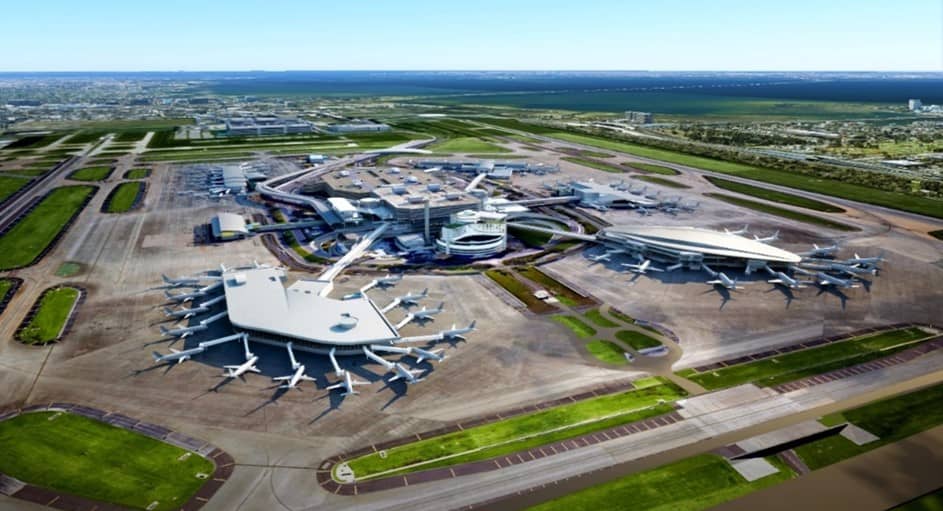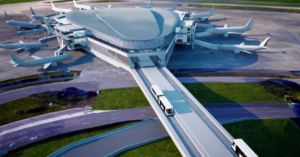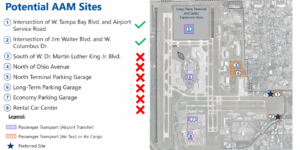Know
Tampa airport execs plan new airside, air taxi vertiports

In the next 20 years, over 38.8 million passengers will walk through Tampa International Airport – a massive influx accompanied by new demands airport executives are preparing to handle.
During the last Master Plan Update public hearing, held Tuesday evening at TPA, CEO Joe Lopano and his team say the “most critical” undertaking that will address the capacity and stay competitive in the space will be the construction of a 16-gate terminal for international and domestic travelers – a project titled Airside D.
The $787 million project received approval from the authority’s board of directors in late 2022. Construction is set to start in 2024 and take three years to complete. The airside will open to travelers in 2028.

A rendering of Airside D.
The project site is north of the main terminal is occupied by UPS and for other cargo operators, which will relocate to a new facility.
Lopano shared a video presentation giving attendees a video tour of the new airside, explaining the perspective of a future passenger arriving at TPA from France or Amsterdam.
The passenger will enter the terminal and go into a second level of a corridor that overlooks the departure level. Another set of escalators will lead to the baggage claim area.

A rendering of Airside D and shuttle service.
“This isn’t a baggage claim in the basement somewhere you walk half a mile to get to it. This is on the top floor. You go right through U.S. Customs, and then you go down an escalator to our shuttle system,” Lopano said. The shuttle takes the passenger(s) to the main terminal.
Renderings also show an outdoor restaurant, a food court and a retail area in Airside D surrounded by glass walls.

An interior rendering of Airside D.
From an outbound perspective, a passenger would step onto the shuttle from the existing main terminal. After disembarking the shuttle, the passenger would walk to the security check-in area.
Lopano said the Hillsborough County Aviation Authority, which governs TPA, will award a design contract for the buildout at an upcoming board meeting.
The 16-gate terminal will have the flexibility to accommodate up to 45 gates as demand increases.
The Airside D project is part of TPA’s third and final phase of the MPU. This phase also entails the expansion of the main terminal’s baggage claim areas to serve more passengers, and the renovation of the second-floor ticketing level to improve and modernize the customer check-in experience.
This next phase comes after TPA has sustainably completed Phase 2, which kicked off in 2019. It focused on a curbside expansion and 35-acre commercial development around the consolidated rental car center and SkyCenter One, a 275,000-square-foot building that serves as HCAA’s headquarters.
The airport also completed the construction of the utility central plant express curbsides project, which allows passengers without checked luggage to bypass the ticketing level and arrive directly at the transfer level of the main terminal.
The express curbsides are available to passengers flying on American Airlines, Delta Airlines, United Airlines, Frontier Airlines, JetBlue Airways, Copa Airlines, Cayman Airways and Swift Air. TPA is completing the express curbsides for the “Red Side” serving the additional airlines. The new curbsides will be completed in early 2025.
Today’s current demands
The airport serves roughly 23.45 million passengers a year for an average of 52,000 passengers per day.
“We can fit everyone who goes to Raymond James Stadium into this airport every day,” Lopano said.
The airport, which is the 26th busiest airport in the U.S., serves 93 nonstop destinations.
These are the top 10 destination markets for TPA:
- New York
- Chicago
- Atlanta
- Boston
- Philadelphia
- Detroit
- Dallas
- Denver
- Washington, D.C.
- Minneapolis
“We have seen a tremendous rebound and great entries into the Caribbean [post-Covid],” Lopano added, listing off connections to Punta Cana and Santo Domingo in the Dominican Republic, Montego Bay, Jamaica and San Juan, Puerto Rico.

Lopano also presented a map showing the largest unserved domestic and international markets from TPA.
Vertiports for advanced air mobility
In embracing future technologies and projects to expand TPA’s offerings, airport consultant Pete Ricondo said TPA is also considering building vertiports, or helipads, for future electric vertical take-off and landing (eVTOL) vehicles.
The aircraft, commonly referred to as “air taxis,” can support a limited number of passengers and cargo transportation.
Ricondo said the HCAA has been leading this effort as deployment can start as early as 2025 for the piloted aircraft, which will likely become fully autonomous.

TPA studied eight different potential sites for vertiports and identified the top two.
There are two preferred vertiport sites: One at the intersection of West Tampa Bay Boulevard and Airport Service Road and another at the intersection of Jim Walter Boulevard and West Columbus Drive.
Ricondo said the airport executives and consultants have engaged with advanced air mobility operators to determine their needs and the best locations.
There isn’t a projected cost estimate yet related to the construction of the vertiports.
A future connection to Westshore
Since 2016, when the Florida Department of Transportation purchased property in Westshore for a future intermodal center, actions have been somewhat stagnant at the acquired Doubletree Hotel and Charley’s Steakhouse sites.
“The airport was built at a time when [Interstate] I-4 and the Howard Frankland Bridge were new with five or four cars on there at one time,” Lopano said, addressing a requested update from land use and property rights Tampa attorney Ron Weaver.
“We are at the point where we can’t continue to ride free on these roadways. In addition, there’s not a lot of room for parking lots to be built here. This is not a new idea to have mass transit to an airport,” Lopano said. “What’s going to happen when 38 million passengers come? I think the community needs to come to recognize that if they want the airport to grow, they are going to have to grow the other infrastructure that feeds the airport.”
Jeff Siddle, assistant VP of planning and development, said the execs are talking with the DOT about the potential airport-to-Westshore linkage.
“At the right time when that happens, the airport will be ready,” he said.







